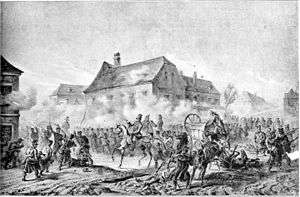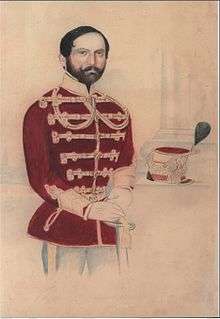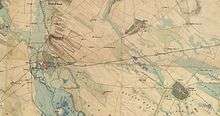Battle of Hatvan
| Battle of Hatvan | |||||||
|---|---|---|---|---|---|---|---|
| Part of the Hungarian Revolution of 1848 | |||||||
 | |||||||
| |||||||
| Belligerents | |||||||
|
|
| ||||||
| Commanders and leaders | |||||||
|
|
| ||||||
| Strength | |||||||
|
Total: 14,563 men -VII. corps: 8622 -Detached units of the III. corps: 5941 56 cannons |
11,000 men 40 cannons[1] | ||||||
| Casualties and losses | |||||||
| 20 men |
Total: 202 men -48 dead -49 wounded -85 missing and prisoner[2] | ||||||
The Battle of Hatvan was the first battle in the Spring Campaign of the Hungarian War of Independence from 1848–1849, fought on 2 April 1849 between the Habsburg Empire and the Hungarian Revolutionary Army. This battle was the start of the Hungarian offensive, which had the purpose to liberate the Central and Western parts, and the capital of Hungary, occupied by imperial forces. The Austrian force were led by General Franz Schlik, while the Hungarians were led by Colonel András Gáspár, and lieutenant-colonel Ernő Poeltenberg. In the Hungarian army fought also the Polish Legion under the lead of Colonel Józef Wysocki. The Hungarians were victorious, and advanced towards the Hungarian capitals, Buda and Pest.
Background

After the Battle of Kápolna in 26–27 February 1849, the commander of the Austrian imperial forces Alfred I, Prince of Windisch-Grätz, taught that he destroyed the Hungarian revolutionary forces once and for all. He wrote on 3 March in his report sent to the imperial court in Olmütz, that: "I smashed the rebel hordes, and I will be in a few days in Debrecen (the temporary capital of Hungary)".[3] Despite of this he did not attacked the Hungarian forces, because he did not got any reliable informations about the number of the Hungarian forces in the case if he would cross the Tisza river. But because of his alertness he lost the opportunity to win the war. While he was thinking of attacking or not, the Hungarian commanders who were discontented with the disappointing performance of Lieutenant General Henryk Dembiński as high commander of the Hungarian forces, accusing him because the loss of the Battle of Kápolna, started a "rebellion", making a meeting in Tiszafüred, which forced the Government Commissioner Bertalan Szemere to depose the Polish general and put Artúr Görgei instead. This infuriated Lajos Kossuth, the President of the National Defense Committee (interim government of Hungary), wanting to execute Görgei for rebellion. Finally he was forced by the support of the Hungarian generals for Görgei, to renounce to his plan, and accept the deposition of Dembiński. But Kossuth's antipathy towards Görgei prevented him to accept the decision of Szemere, but he named Lieutenant General Antal Vetter as high commander instead.[4] But Vetter got ill on 28 March, so after two days Kossuth was forced to name Görgei as temporary high commander of the Hungarian main forces.[5] These days and weeks of unrest, uncertainty and changes, could be an excellent opportunity for Windisch-Grätz to cross the Tisza river and defeat the Hungarian army once and for all. But the Austrian field-marshall, paralyzed by an increasing fear of a Hungarian attack, instead of attacking, tried to inform himself about the numbers and strength of the Hungarian armies which were on the Eastern bank of the Tisza river, but his spies were unsuccessful in obtaining any information. Because of this he scattered his troops to prevent a bypass attack from the north, which he feared, will relieve the imperial siege against the fortress of Komárom, which could cut his support lines.[6]
In the meanwhile at 30–31 March the plan for the Spring Campaign of the Hungarian army was made, the most capable generals were named in the lead of the Hungarian army corps, which prepared to attack the Austrians under the lead of the most capable Hungarian general, Atrúr Görgei. The Hungarian army, led by general Artúr Görgei, designated to start the attack to liberate the Hungarian lands which lied to West from the Tisza river (consisting of much of the territory of the Kingdom of Hungary, occupied by the Habsburg forces), numbered 47 500 soldiers and 198 cannons, organized in 4 army corps, led by General György Klapka (I. corps), General Lajos Aulich (II. corps), General János Damjanich (III. corps) and Colonel András Gáspár (VII. corps). The imperial forces led by Alfred I, Prince of Windisch-Grätz numbered 55 000 soldiers and 214 cannons and rockets, organized in 3 army corps, led by Lieutenant Field Marshal Josip Jelačić (I. corps), Lieutenant General Anton Csorich (II. corps), General Franz Schlik (III. corps), and the division led by Lieutenant General Georg Heinrich Ramberg.[7]
Prelude

The Hungarian plan of the Spring Campaign, elaborated by Antal Vetter, was that the 7th corps, under the lead of András Gáspár, had to attract the attention of Windisch-Grätz on his troops by making and attack from the direction of Hatvan, while the other three corps (I., II., III.) would encircle the Austrian forces from South West, and cut them from the capital cities (Pest and Buda). According to the plan, the 7th corps had to stay at Hatvan until 5 April, than on 6th it had to reach Bag. The attack on the Austrian forces had to occur on 7 April at Gödöllő, from two directions, while the I. corps would advance to Kerepes, and fell on the Austrians from behind, preventing them to retreat towards Pest.[8] The key of this very risky plan was that the Austrians would not discover the Hungarian movements until they completed the encirclement. This is why on the shoulder of the Hungarian commander of the VIIth Corps, András Gáspár, lied a very big responsibility to lead his troops in a way which will not betray the campaigns strategy. This meant that he had to make the enemy commander who faced him, to think that the is face to face with the whole Hungarian army, distracting his attention about the I., II., and III. Hungarian corps, which in the meanwhile, were advancing towards Gödöllő from South-East. If Gáspár would have failed this task, Windsich-Grätz could been sent huge troops to destroy him, which would have been open before them the way to the interim Hungarian capital, Debrecen.[9]
_p008_K%26K_Kavalerie-General_Franz_Schlik_zu_Bassano_und_Wei%C3%9Fkirchen.jpg)
On 1 April a division of Gáspár's VIIth corps, led by lieutenant-colonel Ernő Poeltenberg was in Hort, and only a minor unit of it stationed in Hatvan. The III. corps of the imperial army led by Franz Schlik, came from West, entered the town and chased out the Hungarians towards Hort, killing two Hussars. Schlik was sent by Marshal Windisch-Grätz in reconnaissance of force to find out about the number and the placement of the Hungarian armies in that region. Hearing this, Görgei sent colonel András Gáspár with a division to, commanding to him that he must defend Hort with any cost.[10]
Battle
On 2 April, at 5 o'clock, the two Hungarian division commanders ordered a cavalry reconnaissance towards Hatvan, which report made Gáspár to think that the enemy has a squadron in front of Hort, and the edge of the vineyards was taken by enemy infantry. So he decided to push his vanguards forward, and his division to West from Hort village. At 11:30 he received the report from his vanguards, that other Austrian cavalry squadrons are coming together with many kaiserjägers. Gáspár sent two squadrons of hussars, but when seeing that the imperials sent more cavalry together with cannons, he ordered to the two divisions to move a little backwards and to take the battle order on the heights before the second stone bridge, West from Hort.[11]
The troops of Schlik which came out of Hatvan, were led by the Parrot-brigade, to which he ordered to advance against the enemy troops from Hort, in order to force them to reveal their strength. According to some accounts, Schlik was in a funny mood, and sayed to his officers that this battle will be a joyous rabbit hunt.[12] He did not presumed that in the end his troops will become the hunted. At 1 o'clock the Parrot-brigade came face to face with the troops of Gáspár and Poeltenberg, and started the attack. Schlick also ordered to two infantry brigades together with one cavalry brigade to join the attack.[13]

Until 3 o'clock the battle continued mostly with cannonade. Gáspár was waiting that his two cavalry squadrons sent to Ecséd, and the brigade sent to Csány to arrive, before he palnned to start the attack. In the meanwhile Schlik was incapable to advance. In this moment the detached troops arrived and Gáspár gave the order to attack. He sent three brigades from the division of Poeltenberg to encircle the wings of the enemy. The cavalry squadron and the two cannons led by lieutenant-colonel Lajos Zámbelly moved around the left wing, while the Liptay-brigade advanced on the right wing. In this time Gáspár did not moved, because he waited for his troops to encircle the enemy. But Schlik felt that something dangerous is happening, and ordered his troops to retreat on the vineyard hills between Hort and Hatvan. The Poeltenberg division advanced, and with the troops commanded by Zámbélly and Liptay, from three sides they started a concentric attack against Hatvan. Schlik, after positioning some of his infantry and artillery on the heights in front of the bridge on the Zagyva river, ordered to his sappers to make another bridge to enable him to retreat hist troops, cannons and baggage from Hatvan as fast as possible. In the meanwhile general Damjanich sent from the III. corps the division led by Józef Wysocki, whose approach was observed by Schlik, and the Austrian retreat became more panic-stricken. In the end the imperial infantry which defended the Zagyva bridges, and the crossing to the other bank of the imperial troops, succeeded in breaking down the both bridges on the river, thus preventing the Hungarians to catch them up and encircle them. Schlik's cavalry retreated between Bag and Hatvan, while his infantry and artillery to Aszód, than to Gödöllő.[14]
Aftermath
The battle of Hatvan was not a very important victory, but its influence on the moral of the Hungarian troops was remarkable. The most important result of the battle was that Gáspár succeeded to make Schlik to think that he faced the whole Hungarian army, and not just its VIIth corps. Windisch-Grätz continued to be unsure about the plans and displacement of the Hungarian main army, and because of this he remained mostly incapable of stopping them to advance from two sides, towards his headquarters at Gödöllő. After the victory of Hatvan, the other, more numerous Hungarian army, consisting of three corps, won at Tápióbicske another victory, than neared to Isaszeg, where, on 6 April, the decisive battle of the first phase of the Spring Campaign took place.
This victory brought to Colonel András Gáspár the title of general, together with the position of leader of the VIIth corps[15] Before this he was only temporary commander of this corps, because Görgei, who was its leader, had to resign from it, because he took the lead of the whole Hungarian army except the Transylvanian and the Southern armies. Although Lajos Aulich was designated as commander of the VIIth corps, he was away, so until he arrived Gáspár had to fulfill the lead, as the senior staff officer.[16]
Notes
- ↑ Hermann 2001, pp. 269.
- ↑ Hermann 2004, pp. 204.
- ↑ Hermann 2001, pp. 244.
- ↑ Hermann 2001, pp. 244.
- ↑ Hermann 2001, pp. 263.
- ↑ Hermann 2001, pp. 271.
- ↑ Hermann 2001, pp. 268–269.
- ↑ Hermann 2001, pp. 270.
- ↑ Hermann 2001, pp. 270–271.
- ↑ Hermann 2004, pp. 201–202.
- ↑ Hermann 2004, pp. 202.
- ↑ Hermann 2004, pp. 202.
- ↑ Hermann 2004, pp. 202.
- ↑ Hermann 2004, pp. 202.
- ↑ Hermann 2004, pp. 202.
- ↑ Székelyné Kőrösi 2002, pp. 49.
Sources
- Hermann (ed), Róbert (1996). Az 1848–1849 évi forradalom és szabadságharc története ("The history of the Hungarian Revolution and War of Independence of 1848–1849) (in Hungarian). Budapest: Videopont. p. 464. ISBN 963-8218-20-7.
- Hermann, Róbert (2004). Az 1848–1849-es szabadságharc nagy csatái ("Great battles of the Hungarian Revolution of 1848–1849") (in Hungarian). Budapest: Zrínyi. p. 408. ISBN 963-327-367-6.
- Hermann, Róbert (2001). Az 1848–1849-es szabadságharc hadtörténete ("Military History of the Hungarian Revolution of 1848–1849") (in Hungarian). Budapest: Korona Kiadó. p. 424. ISBN 963-9376-21-3.
- Bóna, Gábor (1987). Tábornokok és törzstisztek a szabadságharcban 1848–49 ("Generals and Staff Officers in the War of Freedom 1848–1849") (in Hungarian). Budapest: Zrínyi Katonai Kiadó. p. 430. ISBN 963-326-343-3.
- Székelyné Kőrösi, Ilona (2002). Kecskemétiek a szabadságharcban. II. Kecskemét is kiállítja. Gáspár András, Erdősi Imre, Lestár Péter, Muraközy János, 71. honvédzászlóalj + 16. (Károlyi) huszárezred, Kecskemét város szabadcsapata ("The Citizens of Kecskemét in the Freedom War. II. Kecskemét also Exhibits it. Gáspár András, Erdősi Imre, Lestár Péter, Muraközy János, the 71th Honvéd Battalion, the Guerilla of Kecskemét") (in Hungarian). Kecskemét: Nemzeti Kulturális Örökség Minisztériuma. p. 224. ISBN 963-7216-74-X.